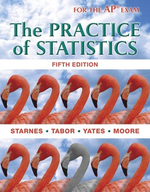Solution Found!
Why men and women play sports Do men and women participate in sports for the same
Chapter 11, Problem 27(choose chapter or problem)
Do men and women participate in sports for the same reasons? One goal for sports participants is social comparison — the desire to win or to do better than other people. Another is mastery — the desire to improve one's skills or to try one's best. A study on why students participate in sports collected data from independent random samples of 67 male and 67 female undergraduates at a large university.Each student was classified into one of four categories based on his or her responses to a questionnaire about sports goals. The four categories were high social comparison - high mastery (HSC-HM), high social comparison - low mastery (HSC-LM), low social comparison - high mastery (LSC-HM), and low social comparison - low mastery (LSC-LM). One purpose of the study was to compare the goals of male and female students. Here are the data displayed in a two-way table:
GENDER
\(\begin{array}{lcc} \text { Goal } & \text { Female } & \text { Male } \\ \text { HSC-HM } & 14 & 31 \\ \text { HSC-LM } & 7 & 18 \\ \text { LSC-HM } & 21 & 5 \\ \text { LSC-LM } & 25 & 13 \end{array}\)
(a) Calculate the conditional distribution (in proportions) of the reported sports goals for each gender.
(b) Make an appropriate graph for comparing the conditional distributions in part (a).
(c) Write a few sentences comparing the distributions of sports goals for male and female undergraduates.
Questions & Answers
QUESTION:
Do men and women participate in sports for the same reasons? One goal for sports participants is social comparison — the desire to win or to do better than other people. Another is mastery — the desire to improve one's skills or to try one's best. A study on why students participate in sports collected data from independent random samples of 67 male and 67 female undergraduates at a large university.Each student was classified into one of four categories based on his or her responses to a questionnaire about sports goals. The four categories were high social comparison - high mastery (HSC-HM), high social comparison - low mastery (HSC-LM), low social comparison - high mastery (LSC-HM), and low social comparison - low mastery (LSC-LM). One purpose of the study was to compare the goals of male and female students. Here are the data displayed in a two-way table:
GENDER
\(\begin{array}{lcc} \text { Goal } & \text { Female } & \text { Male } \\ \text { HSC-HM } & 14 & 31 \\ \text { HSC-LM } & 7 & 18 \\ \text { LSC-HM } & 21 & 5 \\ \text { LSC-LM } & 25 & 13 \end{array}\)
(a) Calculate the conditional distribution (in proportions) of the reported sports goals for each gender.
(b) Make an appropriate graph for comparing the conditional distributions in part (a).
(c) Write a few sentences comparing the distributions of sports goals for male and female undergraduates.
ANSWER:
Step 1 of 5
Given Information:
The sports data is collected from independent random samples of 67 males and 67 females. Each student was classified into four categories like high social comparison-high mastery, high social comparison – low mastery, Low social comparison-high mastery and low-social comparison-low mastery.
